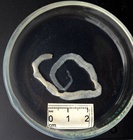RAS taxon details
Cestoda
- Subclass Eucestoda
marine, brackish, fresh, terrestrial
Not documented
RAS (2025). Cestoda. Accessed at: https://ras.biodiversity.aq/aphia.php/aphia.php?p=taxdetails&id=1051 on 2025-09-12
RAS (Eds.) (2025). Register of Antarctic Species. Cestoda. Accessed at: https://ras.biodiversity.aq/aphia.php?p=taxdetails&id=1051 on 2025-09-12
Date
action
by
2004-12-21 15:54:05Z
created
db_admin
context source (PeRMS)
Luque, J.L., C. Cruces, J. Chero, F. Paschoal, P.V. Alves, A.C. Silva, L. Sanchez & J. Iannacone. (2016). Checklist of metazoan parasites of fishes from Peru. Lista de verificación de los metazoos parásitos de peces de Perú. <em>Neotropical Helminthology.</em> 10(2), jul-dic: 301-375. [details] Available for editors 
additional source Waeschenbach, A.; Webster, B. L.; Bray, R. A.; Littlewood, D. (2007). Added resolution among ordinal level relationships of tapeworms (Platyhelminthes: Cestoda) with complete small and large subunit nuclear ribosomal RNA genes. <em>Molecular Phylogenetics and Evolution.</em> 45(1): 311-325., available online at https://doi.org/10.1016/j.ympev.2007.03.019
page(s): 311 [details]
identification resource Chervy, L. (2024). Manual for the study of tapeworms (Cestoda) parasitic in ray-finned fish, amphibians and reptiles. <em>Folia Parasitologica.</em> 71., available online at https://doi.org/10.14411/fp.2024.001 [details]
identification resource Jones, A., Bray, R.A., Khalil, L.F. (1994). Key to the orders of the Cestoda. In: Khalil, L.F., Jones, A. & Bray, R.A. [Editors]. <em>Keys to the cestode parasites of vertebrates.</em> Wallingford: CAB International, 1-2.
page(s): 1 [details]
additional source Waeschenbach, A.; Webster, B. L.; Bray, R. A.; Littlewood, D. (2007). Added resolution among ordinal level relationships of tapeworms (Platyhelminthes: Cestoda) with complete small and large subunit nuclear ribosomal RNA genes. <em>Molecular Phylogenetics and Evolution.</em> 45(1): 311-325., available online at https://doi.org/10.1016/j.ympev.2007.03.019
page(s): 311 [details]
identification resource Chervy, L. (2024). Manual for the study of tapeworms (Cestoda) parasitic in ray-finned fish, amphibians and reptiles. <em>Folia Parasitologica.</em> 71., available online at https://doi.org/10.14411/fp.2024.001 [details]
identification resource Jones, A., Bray, R.A., Khalil, L.F. (1994). Key to the orders of the Cestoda. In: Khalil, L.F., Jones, A. & Bray, R.A. [Editors]. <em>Keys to the cestode parasites of vertebrates.</em> Wallingford: CAB International, 1-2.
page(s): 1 [details]
 Present
Present  Inaccurate
Inaccurate  Introduced: alien
Introduced: alien  Containing type locality
Containing type locality

